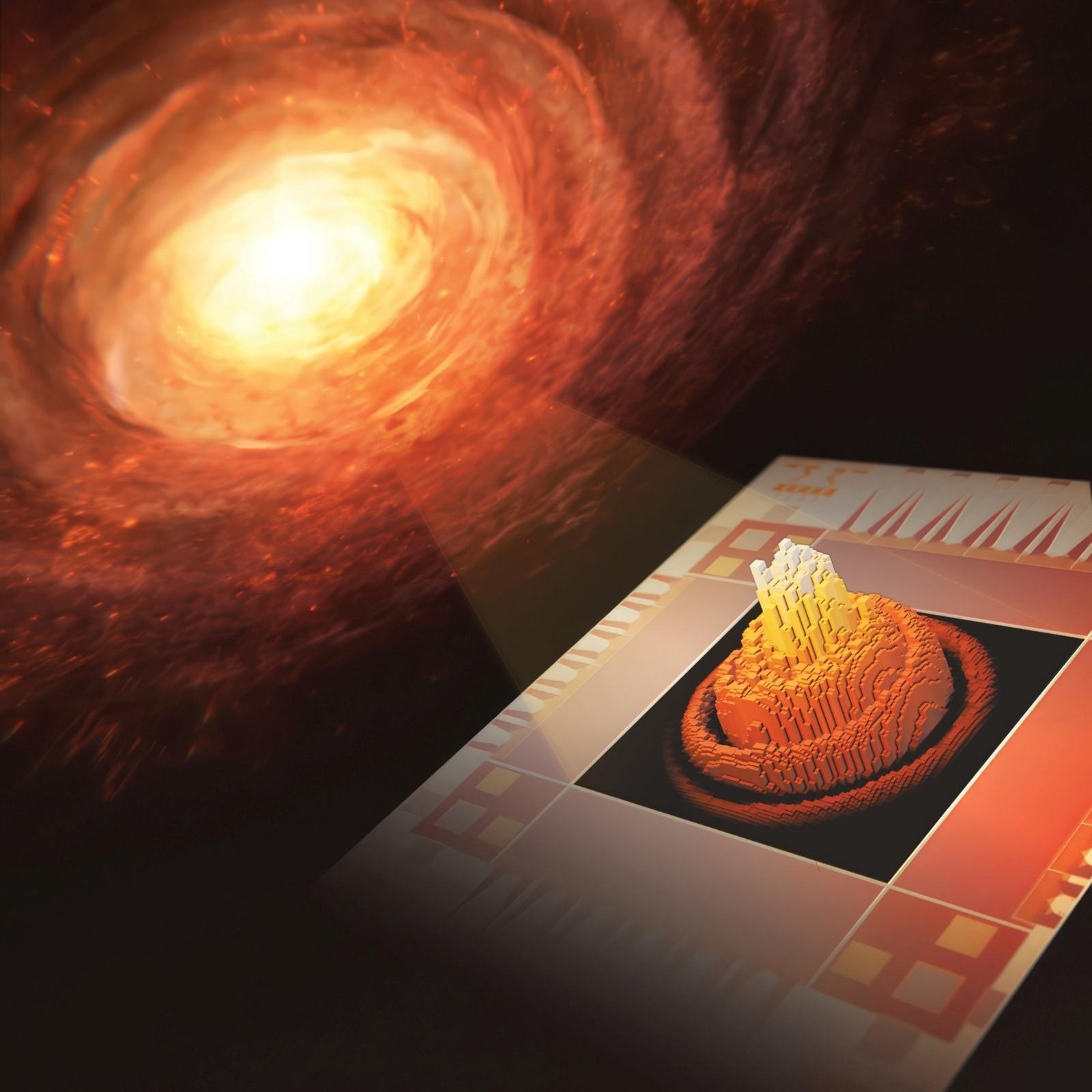Researchers at the National Institute of Standards and Technology (NIST) and their colleagues have created a superconducting camera with 400,000 pixels—400 times more than any other device of its type.
 With planned improvements, NIST’s new 400,000 single-wire superconducting camera, the highest resolution camera of its type, will have the capability to capture astronomical images under extremely low-light-level conditions. Image Credit: pixaby and S. Kelley/NIST.
With planned improvements, NIST’s new 400,000 single-wire superconducting camera, the highest resolution camera of its type, will have the capability to capture astronomical images under extremely low-light-level conditions. Image Credit: pixaby and S. Kelley/NIST.
Superconducting cameras enable scientists to catch very weak light signals from faraway objects in space or sections of the human brain. Having more pixels could lead to many new uses in science and biomedical research.
The NIST camera is composed of grids of ultrathin electrical wires that have been cooled to near absolute zero, allowing current to flow without resistance until a wire is struck by a photon. The energy provided by a single photon may be detected in these superconducting nanowire cameras because it turns off the superconductivity at a specific spot (pixel) on the grid. An image is formed by combining all the photons' locations and intensities.
More than 20 years ago, the first superconducting cameras capable of detecting single photons were constructed. Since then, the gadgets have had only a few thousand pixels—far too little for most applications.
Developing a superconducting camera with a considerably higher pixel count has been difficult since it would be nearly impossible to connect every single chilled pixel among thousands to its readout line.
The difficulty derives from the fact that each of the camera’s superconducting components must be cooled to ultralow temperatures to operate properly, and linking each pixel among hundreds of thousands to the cooling system would be nearly impossible.
NIST researchers Adam McCaughan and Bakhrom Oripov, as well as collaborators from NASA’s Jet Propulsion Laboratory in Pasadena, California, and the University of Colorado Boulder, surmounted this challenge by integrating signals from several pixels onto a few room-temperature readout wires.
Any superconducting wire has the general property of allowing current to flow freely up to a specific maximum “critical” current. To take advantage of this tendency, the researchers supplied a current to the sensors slightly below the maximum. In that case, even a single photon striking a pixel destroys the superconducting.
The current can no longer travel through the nanowire without resistance and is routed to a small resistive heating element linked to each pixel. The shunted current generates an electrical signal that can be detected quickly.
The NIST team built the camera using current technology, with intersecting arrays of superconducting nanowires forming several rows and columns, similar to a tic-tac-toe game. Each pixel—a tiny region focused on the intersection of individual vertical and horizontal nanowires—is individually characterized by the row and column in which it is located.
This technique allowed the scientists to measure signals from a complete row or column of pixels at once rather than capturing data from each pixel, resulting in a significant reduction in the number of readout wires. To do this, the researchers ran a superconducting readout wire parallel to but not contacting the rows of pixels and another parallel but not touching the columns of pixels.
Consider the superconducting readout wire that runs parallel to the rows. When a photon contacts a pixel, the current flowing through the resistive heating element warms a small section of the readout wire, resulting in a tiny hotspot.
In turn, the hotspot generates two voltage pulses that travel in opposite directions along the readout wire and are recorded by detectors at either end. The difference in time between the arrival of the pulses at the end detectors shows the column in which the pixel is located. A second parallel to the columns superconducting readout wire performs a similar role.
The detectors can detect changes in signal arrival times as small as 50 trillionths of a second. They can also count up to 100,000 photons impacting the grid every second.
Oripov made rapid progress in expanding the number of pixels when the team implemented the new readout design. The figure increased from 20,000 to 400,000 pixels in a matter of weeks. According to McCaughan, the readout technology may easily be scaled up for much larger cameras, and a superconducting single-photon camera with tens or hundreds of millions of pixels could be available shortly.
The team intends to improve the sensitivity of the prototype camera over the next year so that it can capture nearly every incoming photon. This will allow the camera to perform low-light tasks such as imaging dim galaxies or planets outside the solar system, quantifying light in photon-based quantum computers, and contributing to biomedical research that employs near-infrared light to see into human tissue.
Journal Reference:
Oripov, B. G., et al. (2023) A superconducting nanowire single-photon camera with 400,000 pixels. Nature. doi:10.1038/s41586-023-06550-2